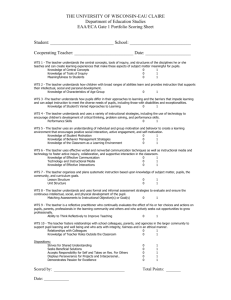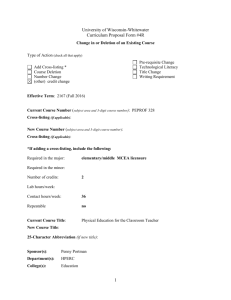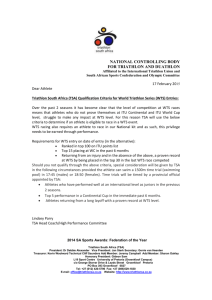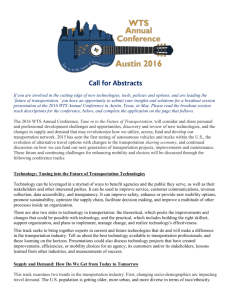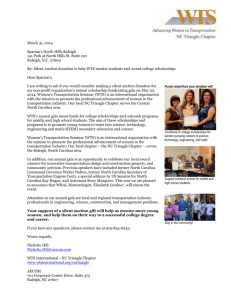UNIVERSITY OF TORONTO Department of Physics Second Year
advertisement
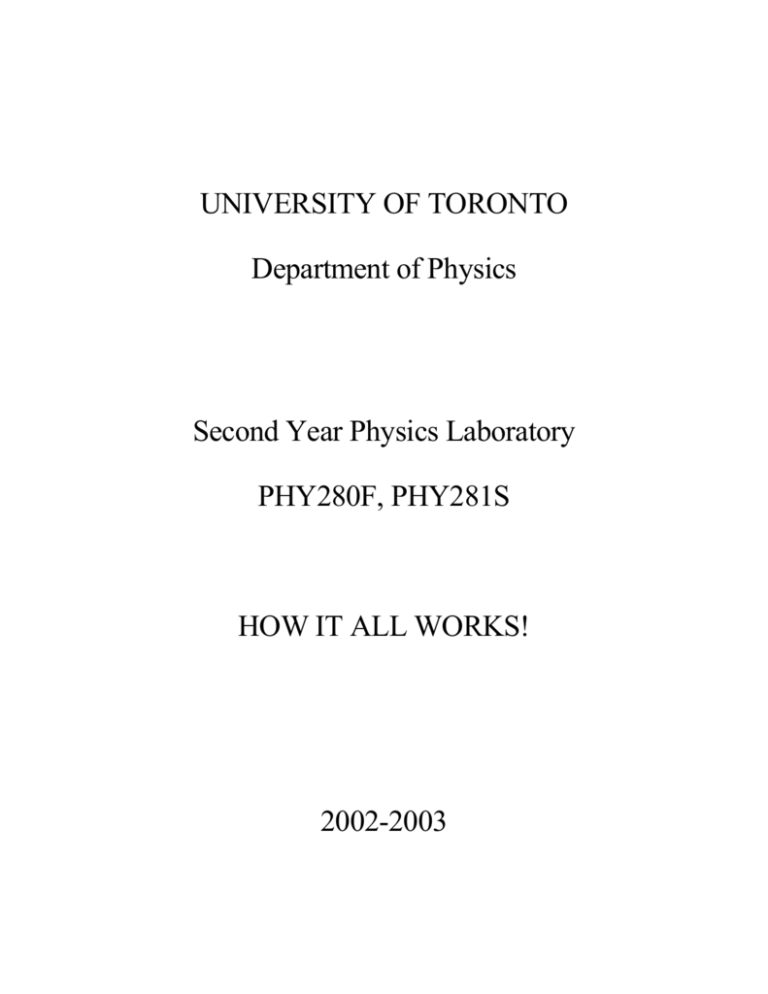
UNIVERSITY OF TORONTO Department of Physics Second Year Physics Laboratory PHY280F, PHY281S HOW IT ALL WORKS! 2002-2003 INTRODUCTION The Second Year Laboratory is designed to extend the experimental skills you learned in the First Year Laboratory. Compared to that laboratory, you will find the typical experiment more complex and the apparatus more sophisticated. Specifically, in the Second Year Lab, we aim to have you improve your ability to: solve problems in a hands-on context, plan an experiment and design a procedure, use laboratory instruments, perform data analysis with appropriate error analysis, keep complete records, appreciate your equipment and what it is really measuring, perform genuine exploratory work. You will probably want to keep your copy of the First Year Physics Laboratory Manual from last year to refer to such parts as the Errors section. Students who did not do the First Year Laboratory on this campus should ask for a copy in room 229. Even more than in the First Year Lab, we offer a wide variety of experiments; you are encouraged to choose those that most interest you. Unlike the First Year Lab, you will perform almost all the experiments on your own, without a partner. Only the experiment requiring four hands, "The Millikan Oil Drop Experiment", may be performed with a partner. The relative sophistication of our experiments compared to the First Year Lab means that our experiments are even more `open ended'. (Experiment lengths are indicated by their weights rating.) The weights given in the experiment listings at the end of these notes are only `typical' values: the actual weight an experiment is worth depends on your choice, in consultation with the staff and demonstrators, of breadth versus depth in doing this laboratory. WHO-WHAT-WHERE? The people responsible for the running of this laboratory are: Academic: Tetyana Antimirova Nigel Edwards (coordinator) 251A 509 946-4071 978-2267 Technical: Howard Okada Tak Sato Phil Scolieri, Rob Smidrovskis, Larry Avramidis 123 250 946-8298 978-0669 229/127 978-2957 In general, the technical staff provide information on apparatus and their specifications, in addition to maintaining and setting-up equipment, etc. The academic staff with the demonstrators (see photo gallery), provide information on experimental procedure and the underlying physics of the experiments, as well as all the other teaching functions that take place in the lab. 1 In addition to the First Year resource centre in Room 126, the Second Year Laboratory has its own resource centre located in Room 229. This centre will always be staffed during scheduled laboratory hours and is the first place to look for a piece of equipment. The resource centre also contains a small library of particular relevance to this laboratory, which is a supplement to the larger library in Room 126 and the Departmental library on the second floor of the Burton tower. These libraries will be important to you as most experiment guide sheets assume that you have gone to other references to work out the significance and details of the experiment. The laboratories themselves occupy 12 rooms located in the North-East area of the second floor of the McLennan Building. The main lab room is 235. Next to Room 235 is a foyer (Room 234) that houses the Guide Sheets for the available experiments and the shelves on which you will keep your lab notebook. Guide Sheets are also available on the lab web page. You should check the web first as we are in the process of discontinuing the practice of producing paper copies. In the hall immediately outside Room 235 is a series of notice boards; you are expected to be familiar with the contents of these boards. LAB PROCEDURES In the Second Year Lab you will have your own demonstrator to whom you will continue to report throughout the year. You will be assigned to a lab group under the supervision of that demonstrator, who will be your group leader and who will monitor your progress throughout the year. However, since the experiments are more challenging than the typical offering in the First Year Laboratory we particularly cannot expect a single demonstrator to be responsible for all the experiments her/his students may perform during the year. Thus, responsibility for individual experiments is divided among the demonstrators, who will serve as your primary resource for that experiment and who will mark your work when you have completed it. Your group leader: Keeps track of your general progress throughout the year, Books the experiments you wish to do, Keeps track of all the marks you receive from the experiment demonstrators, Provides the overall assessment of your laboratory work, Supervises and evaluates the two "exercises" you do, Marks your Formal Report. The experiment demonstrator (responsible for specific experiments): Supervises and evaluates your performance on the experiment, Signs, with you, your contract to do the experiment. Briefs you on the ideas, concepts and details of the experiment, Passes the mark you receive on her/his experiment to the group leader. The laboratory is designed so that its requirements can be largely completed during scheduled hours. The normal lab hours are 9-12am on Tuesdays and 2-5pm on Fridays every second week, depending 2 on which lab section you are in. The dates for each lab section is listed in "The Lab Calendar" later in this document. It is only during these hours that we can guarantee the accessibility of the laboratory staff for questions. Thus attendance during your scheduled laboratory is important and required. You must check in with the experiment demonstrator for the experiment you are performing every time you come to the laboratory. You may only work in the lab "off hours" with explicit permission to do extra work, but this is not a substitute for your presence during scheduled hours. It is generally expected that you will do all writing of experiment descriptions, observations and interpretations in your lab notebook while in the lab. Thus you will normally not take your lab notebook home. There are shelves in room 234 on which your lab notebook will normally be kept. If you do need to remove the books for some extra calculations at home, you may do so. It is important that you receive regular feedback on your performance throughout the year. Thus, when you complete an experiment or exercise, you must: Inform your group leader, who will discuss with you the next experiment or exercise you will do and will move your tag on the booking board, thus freeing the previous apparatus for other students and reserving a new apparatus. Note, you may begin work on your next experiment in the middle of a laboratory period. If you complete an experiment at the end of a lab period, book your new experiment then; don't wait till the next class to book. Leave your lab book with the experiment demonstrator for the old experiment, to be marked when you leave the laboratory that day. It will be marked and available on the shelves in room 234 at your next scheduled laboratory. (If it isn't marked by then, you have a right to complain about slow service.) Go to the experiment demonstrator for the new experiment and sign a contract form. Note that an experiment is considered complete, only when the write-up is done and the work is ready to be marked. Your group leader is instructed to refuse to allow you to continue work on an experiment when a previous completed one has not been submitted for marking. (In other words, you are not permitted to be working on more than one experiment at a time.) LAB REQUIREMENTS EXPERIMENTS: In this lab, any one of a number of experiments could be profitably pursued for the entire year. However, most students find that eventually they have discovered enough physics with a particular apparatus, and wish to move on. You are encouraged to decide, in discussion with your group leader, whether you wish to do this laboratory course by performing a greater number of experiments at a more superficial level or a fewer number in greater depth. The weights ratings given to experiments in the last section of these notes should help to guide you as to the depth of experimentation typically carried out by students in this laboratory. (Recall that a weight is roughly the number of three hour lab sessions needed to perform the experiment to this `typical' level.) The actual weight you receive for a particular experiment is a matter for discussion with the demonstrator responsible for the experiment. Your first experiment will be of a one or two weight length. Later experiments may be longer. In selecting your experiments and weights as well as when 3 planning your experiment, you should manage your time carefully. With the many tasks to perform in the lab, it is all too easy to spend many more hours than scheduled something to be avoided.! Evaluation of experiments will be done by the demonstrator responsible for the individual experiment. For most of your experiments, you will be evaluated using a mix of in-lab assessment and lab notebook examination. For some of your experiments, a short oral interview may form some or all the basis of evaluation. EXERCISES: You are required to complete two exercises, one in the fall term and one in the spring. These exercises are intended to insure that you command two experimental techniques we feel are necessary for experimental physics at this level. They will be marked by your group leader out of 10 according to how well you have mastered use of the technique. (Few lab notebook entries are involved.) However, you must continue to do the exercise until you have obtained at least a 70% performance level. Each exercise takes one lab session to perform. The exercises are: Exercise "2" Exercise "4" Vacuum System (PHY280F) Index of Refraction (PHY281S) FORMAL REPORT: You will write and submit a formal lab report in journal style format. The formal report is due at your last laboratory of the fall term. The formal report serves primarily as a writing exercise and will be marked by your group leader. It will be based on an experiment you have completed. Your group leader will assign which experiment you report on. (See the section on formal report writing below.) MARKING SCHEME: The marking schemes for the two courses are shown below. PHY280F PHY281S EXPERIMENTS 70% (4 wts) 70% (4 wts) EXERCISES 10% (1 exer.) 10% (1 exer.) 20% 20% FORMAL REPORT 4 LAB NOTEBOOKS - What you write and when The keeping of lab records by students in the Second Year Lab is part of your training for your later scientific life. We thus expect that your notebook will resemble that of a professional scientist. The following is an attempt to clarify our lab notebook expectations. WHAT THE NOTEBOOK IS FOR: The notebook provides both a structure for recording your experimental work and a record of that work. Actual, unprocessed records and subsequent calculations made during data collection are saved. In a research company, the records are also legal records. In court proceedings, the dated, original lab notes may the critical evidence in a patent dispute. WHEN ENTRIES ARE MADE IN THE NOTEBOOK: Whenever you do any work on an experiment, you should be making entries in the notebook. Your notebook is a diary, and so entries are made in chronological order. These entries should all be dated. Notebook entries start with jottings on your preliminary background reading and investigation, progress through records of your experimental set-up, include data (which are both numbers and narrative) and calculations, and end in evaluations and conclusions. All these entries must be made simultaneously with the actions they describe. Indications of idiosyncrasies in the apparatus must be written at the time the idiosyncrasies are observed, not two weeks later. WHAT SHOULD BE ENTERED IN YOUR LAB NOTEBOOK: Dates and times liberally spread throughout the data/figures/narratives. Sketches of important details of apparatus. In most cases, schematic representations are preferable to pictorial detail. This is particularly relevant to electrical circuits. Data numbers, comments and descriptions systematically entered (in tabular form where possible). All the data should be there, including the data that failed (with annotation of why it failed). In particular, all anomalies and surprises and your reactions to them should be included. Note that error estimates are part of your data. Preliminary calculations based on the data, preferably also in tabular form, and preferably as extended columns in the data table. Do not include detailed arithmetic, although algebraic equations, explaining how each calculated column in the table was found, are useful. Preliminary graphs based on the preliminary calculations and inserted with the data. These graphs should be well labelled and dated and should be liberally annotated with remarks about features of the graph as related to oddities in the data-gathering process. These preliminary calculations and graphs should always be made while the data are being accumulated. If you take your data home and start to plot them days after the laboratory and find you made a trivial experimental mistake, you could waste a great deal of time repeating the observations that could be better spent! Data sheets produced by your equipment (chart recorder sheets etc.). Such sheets should be dated and cross-referenced to the writing in your book and annotated re notable occurrences. Loose 5 sheets should be taped into the book. In the event that data are saved in computer files, complete descriptions of filenames and locations should be included. Final, more elaborate, calculations and graphs, and descriptions of the methodology and strategies used in the calculations. Final comments, conclusions, thoughts about the experiment. NOTE: Your notebook is not a formal report it is not a beauty show. It does contain everything about the experiment that is not already recorded elsewhere. (And, if you happen to be tempted to write on scraps of paper in the lab, don't use those scraps rather use your notebook.) LENGTH, ORGANIZATION AND WORK OUT OF THE LAB: Your notebook is your complete record and thus the entry for each experiment must be long enough to allow you to fully reconstruct the experiment from the written record. However, a 50 page entry for a second year experiment is a waste of paper and a waste of your time. This implies that organization is essential to work in the lab. Plan ahead! It is important for you to work out what you will do and write before you start! Try a trial run at the experiment first. It is also important that you organize your work so that no more than one hour is spent working on your notebook after you have completed your experiment. The entries in your lab notebook should be with a permanent pen. FORMAL REPORTS The length of the formal report should be between 600 and 1,000 words. You are reminded that a formal report is an abbreviated way of presenting results. You may submit your report in neat handwritten form, or typed, or word-processed, or type-set. All are equally acceptable. We are not interested in the technology of reproduction of the report. We are interested in what comes out of your own head in writing the report. There is a more or less uniform agreement on the general style in which scientific results are presented. The A.I.P. has issued a Style Manual and a copy of this is available in the laboratory. Jot down on a piece of paper the structure of the report along with the points you wish to make in each section. Structure means Abstract, Introduction, Theory, Apparatus, Method, Observations, Discussion and Conclusion. The subset of these titles of sections used in an actual paper depends on the specific subject matter. Organize your report so that the story it tells the reader flows logically. Look at what you have jotted down to determine if it is complete and in the correct order. The latter is often important in the Discussion section as it may be more readily comprehended by the reader if A is explained before B rather than B before A. Note that, unlike your lab notebook, a formal report does not generally flow chronologically. The following paragraphs indicate the contents you might expect in each section. Obviously the relevant weight you give to each of the specific points depends critically on the particular experiment, so a lot of judgement is required on your part. When you write your report, you won't necessarily write the sections in the sequence they appear in the final presentation. For example, the 6 abstract which appears at the beginning of the paper is the last thing you write. Introduction: This sets the scene by giving some background and what it is that you are actually doing in this experiment. This should be short. This section should include formulae that you will need to analyze your data. You may refer to other work either to contrast your experiment (it being a new style of experiment) or to compare your experiment with that of others. Apparatus: Describe briefly the apparatus or technique used, giving important, relevant parameters. You are trying to establish for the readers the level and quality of your experiment and give sufficient detail that if one wished, one could duplicate your experiment to verify or disprove your results. If you leave out a key piece of information (e.g. the experiment was done at 0.001K not 300K) or add a useless piece of information (e.g. the lens was held in place with a 10-32 screw) then the reader will have doubts about the quality of your experiment. Observations: Try to give at least one sample of your observations, not too far removed from your raw data, e.g. "Fig. 1 shows the spectrum of . . . . . corrected for the dark count of the photomultiplier". An explanation of the figure should follow. Generally you should not include lists of raw data. Tell how you analyzed your data. For example, "Using a least squares fit with Equation N, the parameters α and β were determined". Equation N will have been given explicitly in the Introduction section. Don't give all the numbers or step by step disclosure of the actual computation. A good technique is to ask yourself if you have given enough information so that a reasonably intelligent person could repeat your calculations to see if you had made an error. Give a table of your final results if that is appropriate. Discussion: Although it may be sometimes difficult or inappropriate to separate this section from the last section, you should have a discussion of your results or analyses to compare or contrast with other observations. Conclusions: This is a very brief overview of the major points of your paper. This last paragraph is often the second thing read after the abstract. Abstract and Title: It is now time to decide on an abstract and title for your paper. The abstract is usually a few concise sentences that summarize the problem, what you did and how you did it and the specific results obtained. It partially repeats the ending to your paper. It should entice a potential reader to read the paper. For a sample of journal writing, look up an issue of the American Journal of Physics in the Physics 7 Library. This journal will have articles which you can probably understand while at the same time you will see journal style writing. CRITERIA FOR LAB PERFORMANCE The criteria your demonstrator will use in the lab performance component of the experiment evaluation include the following: PREPARATION: The student has read the guide sheet The student has thought about the experiment The student has investigated unclear material The student has, in advance, made notes in the lab notebook to clarify what the experiment is about The student has not written-up the experiment in advance PERFORMING THE EXPERIMENT: Systematics and organization in setting-up the experiment Systematic wiring of circuits from prepared diagrams Handling of instruments and equipment Calculating of data while taking data Plotting graphs while taking data RECORD KEEPING: Recording all data in notebook while taking data Writing down error estimates while taking data Commenting on goodness or weakness of data while taking data INTERPRETATION: Understanding of what the instruments are really saying Understanding of what the graphs are saying Understanding of limits on instruments and data Understanding sources of error PROGRESS: Is learning taking place? Is improvement being shown? Note that these criteria will be used in your in-lab assessment, in evaluation of your lab notebook and in oral interviews by the demonstrator. THE LAB CALENDAR PHY280F PHY281S 8 P0101 P0102 P0103 P0104 P0101 P0102 P0103 P0104 Sep 10 Sep 24 Oct 8 Oct 22 Nov 5 Nov 19 Sep 17 Oct 1 Oct 15 Oct 29 Nov 12 Nov 26 Sep 13 Sep 27 Oct 11 Oct 25 Nov 8 Nov 22 Sep 6 Sep 20 Oct 4 Oct 18 Nov 1 Nov 15 Jan 17 Jan 31 Feb 14 Feb 28 Mar 14 Mar 28 Jan 10 Jan 24 Feb 7 Jan 14 Jan 28 Feb 11 Feb 25 Mar 11 Mar 25 Jan 7 Jan 21 Feb 4 Mar 7 Mar 21 Apl 4 Mar 4 Mar 18 Apl 1 Formal report due Nov. 29. Formal report due Apr 5. LIST OF EXPERIMENTS The following is an annotated list of experiments available in the laboratory. We also indicate the average weight of the experiments. Experiments marked (I) have a similar version in the First Year Laboratory: if you did the experiment in the First Year, you may not do it again in the Second Year. Note that due to limitations in equipment availability, not all experiments are available at all times. Electricity and Magnetism The Q of Oscillators (3-4 wts): Here you find out about resonant devices. Pulses in Cables (2 wts): Uses fast pulse techniques to observe the laws of reflection of pulses in a coaxial line, and to measure the velocity of such pulses. Currents Through L's, C's, and R's (2-3 wts): Investigations of decays of currents through circuits involving combinations of these basic electric components: also you may investigate steady sinusoidal currents in these circuits. Absolute Determination of εo (3 wts): A direct measurement of the capacitance of a capacitor of simple geometric form is made, and a value for εo is deduced. Magnetic Induction Field of the Earth (1 wt): The magnitude and direction of the magnetic induction (B) of the earth's field is measured using a 9 rotating coil magnetometer. Hall Effect in Thin Films (3 wts): The transverse voltage produced when a current-carrying conductor is placed in a magnetic field is called the Hall effect. In this experiment the effect is observed, the Hall constant is measured for different materials, and the charge carriers are identified for these materials. Noise (2-3 wts): Electrical noise due to electrical pickup and voltage or current fluctuations are always the ultimate limitation in instrument sensitivity. Several types of noise are studied. Two Terminal Devices - Principally Diodes (2 wts): An experiment to plot current-voltage curves directly on an oscilloscope for various resistors, diodes, thermistors. Current Balance (2 wts): A fundamental measurement of current in terms of the force between 2 current carrying conductors. D.C. Power Supply (2-3 wts): The basic operation of a power supply is studied. Thermoelectricity (2-3 wts): An investigation of thermoelectricity. Analogue Computer - Uses of Operational Amplifiers (2-4 wts): An introduction to the operational amplifier with the solution of some simple dynamical problems. Vibrations, Waves, and Optics Ripple Tank, Water Waves (1-2 wt): A study of two dimensional transverse wave propagation and particularly small amplitude water waves. Polarization of Light (2 wts): A study of the reflection of polarized light at an air-glass interface. Interferometers (1-3 wts): An investigation of various interference phenomena using Michelson, Twyman-Green and FabryPerot interferometers. Velocity of Ultrasonic Waves in Water by the Debye-Sears Effect (2 wts): Optical diffraction grating type effects in a liquid with an ultrasonic sound wave propagated 10 through it. Slinky Waves (1-3 wts): A study of waves in a dispersive system. The slinky permits wave propagation only under certain conditions. Microwaves (2-4 wts): Experiments studying microwaves, microwave transmission down a waveguide, and some antenna characteristics. Seismic Reflection Analogue (2-3 wts): An acoustic analogue model of seismic reflection measurements such as are commonly performed in Geophysics. Here, interference phenomena are looked at in the time-domain. Holography (2 wts): Making of an hologram using a single-beam method. Fundamental Constants The Cavendish Experiment (2 wts): Determination of the fundamental constant ``G'' by means of the classic experiment. (I) Kater Pendulum (2-3 wts): A classic experiment capable of determining g to at least 1 part in 2000; a bit more effort should yield a result accurate to 1 part in 104. Electron Spin Resonance (1-2 wts): Determine the gyromagnetic ratio and Landé g factor of an electron. Photoelectric Effect (2 wts): A means of determining Planck's constant, h, by a conceptually simple and fundamental method. The experiment requires considerable thought about what the apparatus is really doing. Charge to Mass Ratio of the Electron (e/m) (1 wt): A fundamental constant determination using measurements of an accelerating voltage, a magnetic deflecting field, and a distance of deflection of an electron beam. This gives good practice in evaluating the performance of the apparatus. (I) Millikan Oil Drop Experiment (2 wts): A direct measurement of the value of the charge on the electron (e). Nuclear and Atomic Phenomena 11 Radioactivity in the Air (2 wts): A measurement of levels and types of radioactive materials that are found in the air around us. Gamma-Ray Spectra (2-4 wts): Measurement of the gamma ray spectra from various sources using a scintillation counter and a germanium detector. High Energy Physics (3 wts): Using films obtained of interactions in a liquid hydrogen bubble chamber at SLAC, you will analyze the reactions and identify the particles involved. Frank-Hertz Experiment (1 wt): A measurement of the first excitation energy and of the ionization potential of Mercury vapour. Zeeman Effect (2-3 wts): A measurement of spectroscopic line splitting of atomic emission in a magnetic field. This experiment requires some understanding of Quantum Mechanics. Other Similarity (1-3 wts): The motion of solids in viscous fluids is studied with an emphasis on considerations involving the changing of scales of the physical quantities. Gravity of the Earth (2 wts): The changes in the earth's gravitational force are measured up the Burton tower. Hence the radius of the earth is calculated. Of particular interest is the effect of the tower. `g' Using Precession of an Air Gyroscope (2 wts): A measurement of the precession of a truncated rotating sphere in the earth's gravitational field. (I) Evaporation of a Silver Film (1 wt): An application of vacuum system techniques. Heat flow: Tortured rubber and Bessel functions (4 wts) An easy experiment that gives good data but requires a very basic knowledge of Bessel functions for interpretation. 12
